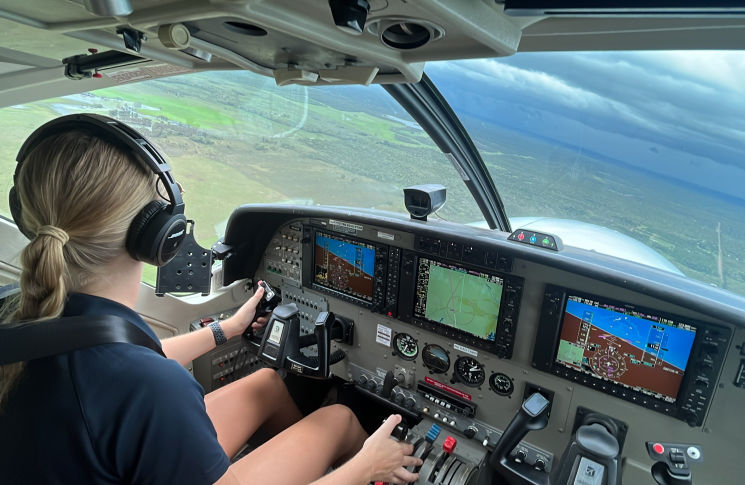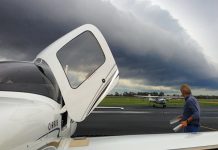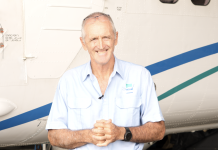Many pilots dream of owning an aeroplane and having it in a hangar at home.
As a result, airparks are starting to pop up around Australia. Look in through the doors of a hangar at an airpark and be prepared to be envious of pristine painted concrete floors and gleaming aircraft.
They give you the idea that it’s a good thing to have one of your most precious assets – and all-encompassing hobby – close at hand where you can tend to it easily. Generally, there will be a corner of the hangar with a neat row of tools and manuals, an aviation calendar and a kettle. Perfect.
If you’re flying into an airpark arrangement like Tocumwal or Narromine, you’re landing on a public runway. But if you fly in to visit a mate who has their own land, hangar and strip, it’s a different story. You are going onto private property and there’s many legal reasons for both pilot and owner to be cautious.
As pilot in command, you are responsible for the safe operation of the aircraft. Here are some things to check:
- Permission: Check with the owner you have their permission to fly in, at a specified time, and the strip is serviceable. The reply might be, ‘I’ll just go and get the sheep off the strip’ or ‘The cattle chewed it up over winter and now it needs regrading.’
- Identification: Private strips are invariably on a farm and are grass or dirt. An Ansett pilot told me they flew to a remote West Australian cattle station in the 1960s in the middle of a summer day and couldn’t find the strip. Only later, when they returned, did the lower sun throw shadows that allowed them to identify the graded airstrip. The station manager said, ‘I’ve been watching you fly around all afternoon!’ Now, with greatly improved satellite navigation and EFBs, you can check the landscape beforehand so you know where you are headed.
- Landing instructions: Not all private strips have a windsock or aerodrome markers. The windsock, in particular, is a big issue. During even a short flight, the wind can change and there have been fatalities and near misses due to lack of information about the wind direction.
- Precautionary search: Conduct one, even though permission has been granted to use the strip and the landowner has confirmed it is both serviceable and free of hazards; the final decision to land still rests with the pilot in command.
Animals
The earth is fixed and the wind is variable – but animals are mayhem. Anatole Mills, a pilot and operator in Victoria, relayed the story of his grandfather landing a light aircraft in Tasmania. As he was trying to touch down, he found the aircraft wouldn’t settle. It came to a slow halt and then ‘settled’ as the expensive sounds of crunching metal alerted him that the landing had not gone to plan. When he climbed down, he found, alarmingly, he had landed on a horse, which had broken free after getting a fright when the aeroplane flew low over the shed where it was penned.
The most common animal-related problem on private strips in Australia is the unpredictable behaviour of kangaroos. It is common to be well into the take-off roll and have a mob of kangaroos bound out of a nearby paddock. They can come from nowhere – well, nowhere the pilot can see while fixated on the runway ahead. They hide in trees, hedges, long grass – they are everywhere and they are fast!
Less of a problem because they are usually fenced away from the strip are sheep, cattle and, hopefully, the owner’s dog. I say ‘hopefully’, because the strip is usually close to the house and forms part of the family’s pattern of life. For example, all our kids learnt to handle a ride-on mower, tractor, car and motor bike on the straight and level, mowed grass runway.
Insurance
If you own a private airstrip, it is prudent to hold insurance to protect you from claims for damage and personal injury caused by your negligence, for example, poor airstrip maintenance or leaving general property or farming equipment in a hazardous location on or adjacent to the airstrip.
Jenna Davies, southern regional manager for aviation at QBE Aviation, says preparation and planning are essential when landing on a private strip. ‘Pilots are responsible for ensuring they have all relevant and available information and that the strip is suitable for their aircraft on that particular day,’ she says.
‘One risk worth planning for is wildlife avoidance, whether that be birds, stock or wildlife such as kangaroos or wallabies. A good discussion with the owner of the private strip before arriving can usually help with gathering useful insight into wildlife habits and frequency of sightings and times. Then do a precautionary pass of the strip on arrival. Scanning specifically for wildlife can also assist with managing this avoidable risk.’
- Capability: This is a huge factor for landing on a private strip. Usually, the runways are shorter and narrower than at a public aerodrome. There will be obstacles such as powerlines, trees, roads and neighbours. The first 3 are important in the immediate sense, but how you treat the neighbours will be your legacy. Listen carefully to the owner’s instructions and guidance for the approach and landing. Neighbours are widely regarded as a farmer’s greatest asset. And if they’re not aviation minded, then the owner has only so many jellybeans in the jar before relations become fractured. If you want to be invited back, don’t dip into the jellybeans. You must know the local fly-neighbourly procedures. If the strip is country rather than outback, you would be wise to consider the local ag operator’s movements also. Yes, they work on weekends as well!
Davies says if you damage your aircraft at a private airstrip, it’s best to stay put and call for assistance or advice from your aircraft insurer or insurance broker, before deciding to carry on.
‘We understand that if your aircraft is damaged away from home, you way may wish to depart and return to your home strip or somewhere more familiar,’ she says. ‘However, it is important to remember that there may be damage to the aircraft which is not necessarily visible from a quick walk-around, or the airstrip may not be in a condition to successfully take-off again following an incident.
‘If you find yourself unable to depart from the private airstrip due to aircraft or airstrip damage, then your aviation hull and liability insurance may cover you for both reasonable recovery expenses and any reasonable emergency expenses necessarily incurred to ensure the immediate safety of the aircraft. Of course, not all policies are the same, so it is important to review your policy to understand what your cover provides in the event of accidental loss or damage to your aircraft.’
She says airstrip owners should understand what their insurance provides cover for. ‘In the event that someone landing at your airstrip, whether invited or not, causes damage to your property or sustains damage to their aircraft, I recommend you immediately contact your aviation insurer or insurance broker for assistance and guidance.’
Going to visit mates is part of the fun of GA flying but it is really important to make sure you are capable, the coast is clear and your host is prepared for your arrival.






Comments are closed.